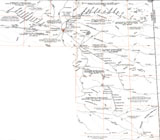The Canadian Northern Western
It is apparent that as early as 1908 Nordegg, with others of the German Development Company, applied for and received a Dominion Charter for the Alberta and Brazeau River Railway Company in order to transport the coal from the Brazeau-Bighorn area to markets.4 The line was to start from a point between Olds and Innisfail on the Calgary and Edmonton Railway and follow the valleys of the Red Deer, Raven and Clearwater rivers, to Rocky Mountain House and Kootenay Plains; and from there to a point between the Bighorn and Sheep rivers to the Brazeau and McLeod rivers to a point on the Grand Trunk Pacific Railway.
Failing to interest either the Canadian Pacific or Grand Trunk Pacific companies to build a line,5 Nordegg turned to William Mackenzie and Donald Mann of the Canadian Northern Railway.6 After hard bargaining these railway promoters agreed to take a fifty percent interest in Brazeau Collieries Limited and to build the railway line, but under the Provincial charter of the Canadian Northern Western Railway (CNoWR), 1910, which would commence at Stewartwyn south of Stettler. The actual point of departure was Warden on the Alberta Midland (CNoR).
Despite the reservations of the Board of Railway Commissioners and the vigorous protests of the Alberta Central Railway, the CNoWR continued to build west audaciously using some of the ACR’s (CPR) own surveying data in determining its route.7 However, the Alberta Central’s surveyors first reached the North Saskatchewan River and determined a crossing for their line. It was this party that Nordegg came across on one of his trips between Red Deer and the mine. Realizing that for the CNoWR to reroute its line and build another bridge would be exorbitantly expensive he managed, through negotiation with the Canadian Pacific, to come to an arrangement whereby the CNoWR would obtain running rights over the bridge.8 A formal agreement in 1914 between the CNoWR and CPR gave the former running rights over the line between Otway and Ullin (known as the joint premises), while the latter could run its trains to Nordegg.9
The Canadian Northern Western reached the now-named town of Nordegg (the station name was later changed to Brazeau) in August 1914, and awaiting transportation, as a promised by Nordegg, were 100,000 tons of coal.10 This coal was excellent for use in locomotives and was also sold to settlers and industries served by Canadian Northern lines. In 1915, 261,156 tons of coal were shipped from the colliery.11
By way of various amendments to the original act of incorporation, the CNoWR had obtained permission to build an extensive railway network, only a few miles of which were laid down: Peace River Junction to Whitecourt; St. Paul Junction to St. Paul; Camrose Junction to Alliance; and Medicine Hat Junction to Steveville.
In 1954 the CNWR was amalgamated with the Canadian Consolidated Railways, the latter being amalgamated with the Canadian National Railways Company in 1956.12 The line to Brazeau was formally abandoned on September 13, 1986.
Notes | Bibliography | Abbreviations
1. M. Nordegg, The Possibilities of Canada are Truly Great: Memoirs 1906, 1907, edited with an introduction by T.D. Regehr (Toronto: Macmillan of Canada, 1971), p. VII.2. Ibid., pp. 16–17.
3. Nordegg. These explorations are vividly recorded in the above memoirs.
4. Dominion, 7–8 Edward VII, Ch. 79, 17 March 1908.
5. Nordegg, pp. 125–26.
6. Ibid., p. 131ff.
7. M. Dawe, “The Canadian National Railway” in The Little Village that Grew (Red Deer: The North Red Deer 75th Anniversary Committee, 1987), p. 86.
8. Nordegg, The Possibilities of Canada, pp. 181–82.
9. Dominion, 4–5 George V, Ch. 71, 27 May 1914.
10. Nordegg, p. 174.
11. Ibid., p. IX.
12. Canadian Department of Agriculture, Canadian National Railways Synoptical History, p. 232.



